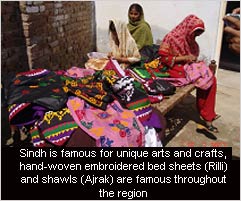Culture
Sindh, due to its relative geographical isolation from the rest of the provinces, has formed its own unique culture. It is rich in arts, music, poetry and literature.
The Sindhi language is a derivate of Sanskrit and is closely related to the ancient Prakrit. It is the official language of the province of Sindh and the second most spoken language in Pakistan.
Sindh is home to two world heritage sites, Mohenjodaro which lies on the right bank of Indus in Larkana district and Makli, in Thatta district. Further, cities like Thatta, Shikarpur, Sukku, Bukku, Rohri and Hyderabad contain some of the most beautiful buildings and old tombs in the country, which are evidence of the rich history of the province.
The people of Sindh are skilled in a variety of arts and crafts. The province boasts of exquisite pottery, variegated glazed tiles, lacquer-work, hand-woven textiles like susi and ajrak and a variety of leather and straw products. 
There are a number of folk festivals that are part of the Sindhi culture. An important fisher-folk festival is held annually at the tomb of Haji Ibrahim in the Shah Bunder taluka in Thatta district. Another popular festival is the Urs (death anniversary) of Shahbaz Qalandar at Sehwan. Shahbaz Qalandar was a renowned saint, whose devout followers include names like Shah Abdul Latif Bhitai, Makhdoom Bilawal, Sachal Sarmast and Qadir Bukhsh Bedal.
Traditional sports are Bitharo, a local form of baseball, Gili Dakar (similar to tipcat) and Tisi, which is a form of hopscotch. For the elite, favourite pass times include falconry, hunting and horse riding.

